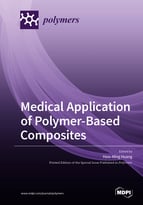Medical Application of Polymer-Based Composites
A special issue of Polymers (ISSN 2073-4360). This special issue belongs to the section "Polymer Applications".
Deadline for manuscript submissions: closed (30 April 2020) | Viewed by 38813
Special Issue Editor
Interests: biomaterials; optomechanronics; dental biomechanics
Special Issues, Collections and Topics in MDPI journals
Special Issue Information
Dear Colleagues,
Polymer composites have been used for various applications in aerospace, automotive, marine, military, and sport industries. Recently, polymer-based composites have received attention in the medical field for fabricating bioactive, resorbable, and cell growth-promoting components for tissue engineering, wound dressing, drug release, dental resin-based composites, and surgical implantation. In this regard, we are organizing a Special Issue on the recent developments and main benefits of various types of polymer composites and their fabrication technologies. This Special Issue is open to any subject related to the development of medical applications of polymer-based composites.
Prof. Haw-Ming Huang
Guest Editor
Manuscript Submission Information
Manuscripts should be submitted online at www.mdpi.com by registering and logging in to this website. Once you are registered, click here to go to the submission form. Manuscripts can be submitted until the deadline. All submissions that pass pre-check are peer-reviewed. Accepted papers will be published continuously in the journal (as soon as accepted) and will be listed together on the special issue website. Research articles, review articles as well as short communications are invited. For planned papers, a title and short abstract (about 100 words) can be sent to the Editorial Office for announcement on this website.
Submitted manuscripts should not have been published previously, nor be under consideration for publication elsewhere (except conference proceedings papers). All manuscripts are thoroughly refereed through a single-blind peer-review process. A guide for authors and other relevant information for submission of manuscripts is available on the Instructions for Authors page. Polymers is an international peer-reviewed open access semimonthly journal published by MDPI.
Please visit the Instructions for Authors page before submitting a manuscript. The Article Processing Charge (APC) for publication in this open access journal is 2700 CHF (Swiss Francs). Submitted papers should be well formatted and use good English. Authors may use MDPI's English editing service prior to publication or during author revisions.
Keywords
- polymer composites
- biomaterial
- tissue engineering
- biodegradable implants
- dental resin-based composites
- wound-dressing composites
- drug-releasing composites







